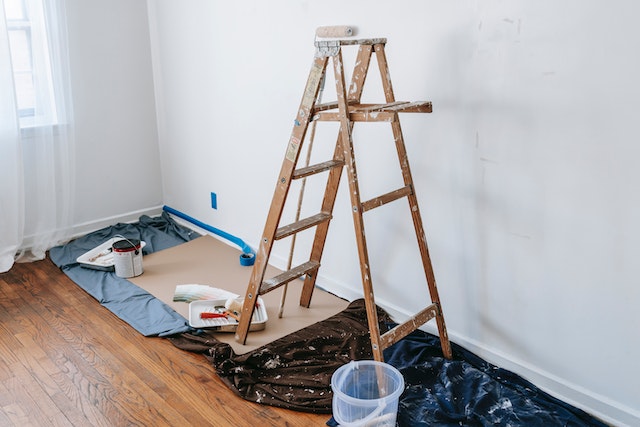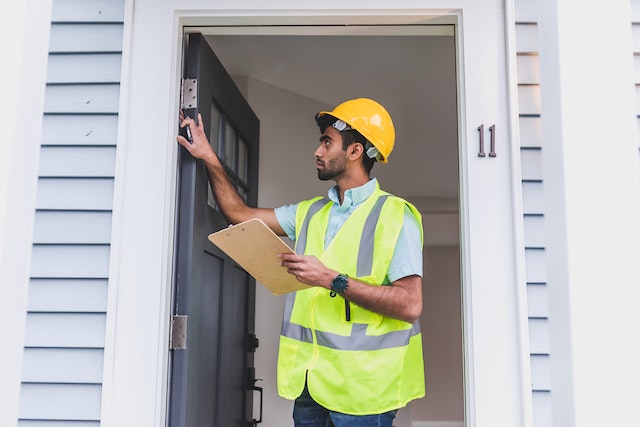
- Install and Maintain Smoke and Carbon Monoxide Detectors: Ensure detectors are present in all required areas, test them monthly, and replace batteries regularly to comply with safety standards.
- Keep Exits Clear and Functional: All doors and windows designated as exits should open easily without obstruction, and hallways and stairwells must remain uncluttered to allow safe evacuation during emergencies.
- Address Electrical Hazards Promptly: Regularly inspect the electrical system for outdated wiring, overloaded outlets, and faulty breakers, and ensure GFCI outlets are installed in appropriate areas to prevent fire risks.
- Prevent and Remediate Mold Issues: Mold can result from water damage due to leaks, roof issues, or poor ventilation; promptly addressing these problems is essential to maintain a healthy living environment.
As a rental property owner, one of your most important responsibilities is to provide a safe living space for your residents. A rental that fails to meet safety standards doesn’t just put your residents at risk, it can also lead to costly fines, legal issues, and property damage.
Understanding cash flow means recognizing how these setbacks can impact your bottom line and long-term profitability. But how do you know if your rental is up to code?
Ensuring your property meets safety standards isn’t just about checking a few boxes. It requires a proactive approach, regular inspections, and an understanding of both local and federal housing regulations.
At Mark Thomas Properties PM, we take pride in helping property owners stay ahead of safety requirements through thorough evaluations, expert guidance, and a commitment to maintaining secure, compliant homes for every tenant.
Why Safety Standards Matter
Safety standards exist to protect the health and well-being of residents. When these standards are not met, the risks range from minor injuries to life-threatening hazards.
Electrical issues can cause fires. Blocked exits can prevent escape during emergencies. Mold can impact respiratory health. And these are just a few examples.
Failing to maintain your property can also hurt your business. Residents are less likely to renew leases or speak positively about your rental if they feel unsafe.

Local governments may issue violations or fines, and in extreme cases, you may be held liable in court if someone is injured due to negligence.
For these reasons, rental safety should be a top priority.
Check for Working Smoke and Carbon Monoxide Detectors
Smoke detectors are essential in all rental units and should be installed in every bedroom, outside each sleeping area, and on every level of the property. Carbon monoxide detectors are equally important in properties with gas appliances, fireplaces, or attached garages.
It’s not enough to install these devices once and forget about them. Batteries must be replaced regularly, and the devices should be tested at least once a month. You should also replace the units entirely after their recommended lifespan, which is usually every seven to ten years.
Make sure residents know how to test the detectors and encourage them to notify you immediately if one starts beeping or malfunctions.
Ensure All Exits Are Clear and Functional
Your rental property must allow for quick and safe exits in the event of a fire or other emergency. This means that all doors and windows that serve as exits should open easily without obstruction.
Bedrooms should have at least one egress window that meets size and height requirements. Hallways, stairwells, and emergency exits must be kept clear at all times. Locks on doors should not require keys from the inside, as this can delay escape during emergencies.

Lighting in hallways and exit areas should be adequate and maintained at all times.
Evaluate Electrical Systems
Electrical safety is non-negotiable. Outdated wiring, overloaded outlets, and faulty breakers are not only code violations but also major fire hazards. An annual inspection by a licensed electrician is highly recommended, especially for older homes.
All outlets should have faceplates, and GFCI (ground fault circuit interrupter) outlets should be installed in kitchens, bathrooms, and laundry rooms to prevent electrical shock. Check that extension cords and power strips are not being used as permanent wiring.
If residents report flickering lights, warm outlets, or tripping breakers, address these issues immediately.
Maintain a Mold-Free Environment
Mold isn’t just an unsightly nuisance; it can cause serious respiratory issues and allergic reactions. While some mold is caused by resident behavior (like failing to ventilate bathrooms), it often results from water damage, such as leaks, roof issues, or poor ventilation.
As the property owner, you’re responsible for fixing leaks promptly, maintaining HVAC systems, and ensuring bathrooms and kitchens are well-ventilated. If mold is present, it should be removed professionally, especially if it covers a large area.
Residents should be encouraged to report signs of mold early so you can take action before it spreads.

Inspect Stairs, Railings, and Flooring
Trips and falls are among the most common injuries in rental homes. Loose handrails, uneven steps, and torn carpets can all contribute to accidents. Regularly walk through the property and inspect these areas closely.
Make sure stair railings are secure and that steps have proper lighting. Outdoor stairs should have non-slip surfaces, especially in areas prone to rain or snow. Inside the unit, ensure that flooring is even and in good condition.
Prompt repairs can prevent both injury and potential lawsuits.
Stay up to Date with Local Codes and Inspections
Safety standards vary by location. Many cities or counties have their own codes that apply to rental properties, including mandatory inspections. Familiarize yourself with these regulations and schedule any required inspections on time.
Some areas also require rental licenses or safety certifications, especially for multi-unit buildings. Failing to meet these requirements can result in fines, orders to vacate, or loss of your right to rent the property.
You can usually find this information through your city’s housing department or rental board.
How a Professional Property Management Company Can Help
Keeping up with safety standards isn’t easy, especially if you manage multiple properties or don’t live nearby. That’s where a professional property management company can be a game-changer.
Property managers are trained to recognize safety issues and stay on top of maintenance before problems arise. They conduct regular inspections, respond to resident repair requests, and know how to navigate local regulations. They also have a network of licensed contractors to handle repairs efficiently and cost-effectively.
Most importantly, they ensure your property remains compliant while reducing the need for your daily involvement. With someone overseeing the safety of your property and the well-being of your residents, you gain peace of mind and help foster a positive landlord-tenant relationship.
If you want to avoid fines, reduce liability, and protect your investment, hiring a property management company may be one of the smartest decisions you can make.
Bottom Line
A rental property isn’t just a source of income, it’s a responsibility. Ensuring it meets safety standards is not only the law but also a reflection of your commitment as a landlord. By following these tips, you’ll create a safe, livable space for your residents.
And if the process ever feels overwhelming, remember that help is available. A trusted property management company like Mark Thomas Properties PM can help you keep everything in top shape. Get in touch today to learn more!
